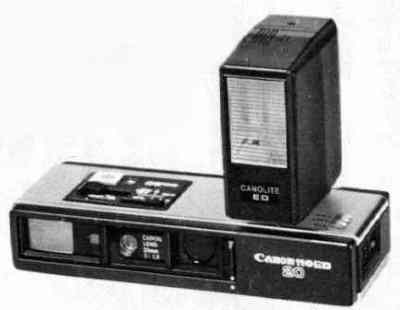
CANON 110 CAMERAS

Canon only made three 110 cameras, but they were all top-notch. These cameras can be reloaded with 16mm film (in 110 cassettes, of course) -- if a small change is made to the cassette. Specifically, these cameras have a tiny cassette sensor along the edge of the film plane. If a notch is cut in the cassette edge to avoid pushing the sensor, the camera will operate normally.
Canon's first attempt at a 110 camera was designed to be a quality shooter. 26mm (f2.7-16.0), (4/4) zone-focus lens. Electronic shutter with speeds of 8 seconds - 1/500. CDS meter provides aperture-priority exposure control. Tripod and cable release sockets. This model could only correctly expose 100 speed film. Uses one 544 battery.
(1975) Improved version of the 110E. It had a faster 26mm (f2.0-16.0), (5/4) rangefinder-coupled lens. Focusing to two feet. Electronic shutter with speeds of 8 seconds - 1/500. CDS meter provides aperture-priority exposure control. Built-in hot shoe. Special ED flash available that provided auto-exposure flash control. Tripod and cable release sockets. Date imprinting function. This model could only correctly expose 100 speed film. Uses one 544 battery.
(1979) Updated version of the 110ED that could correctly expose 100 and 400 speed film. 26mm (f2.0-16.0), (5/4) rangefinder-coupled lens. Close-focusing to 2 feet. Electronic shutter with speeds of 8 seconds - 1/1000 plus a mechanical shutter at 1/125. CDS meter provides aperture-priority exposure control. Built-in hot shoe. Tripod and cable release sockets. Date imprinting function. Close-up photography with accessory close-up lens 110. Measures 5-9/16" X 2-3/16" X 1-1/8" and weighs only 12 oz. Uses one 544 battery.

To return to the main index for the Sub Club click here.
COPYRIGHT @ 1995-2022 by Joe McGloin. All Rights Reserved.